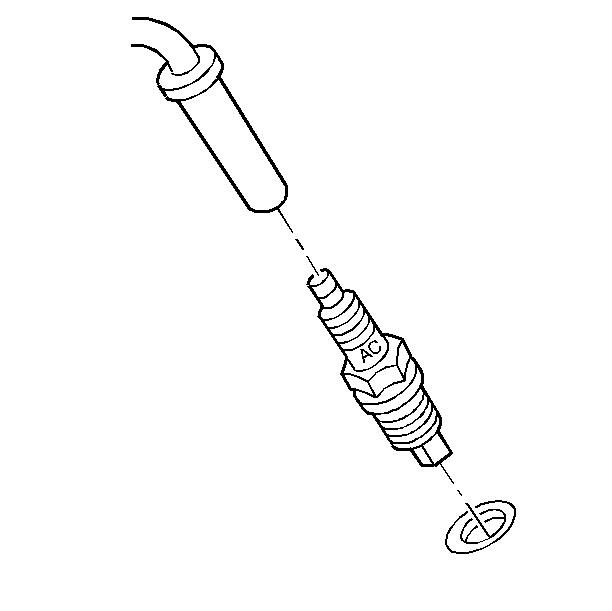Removal Procedure
- Verify that the ignition key is in the OFF position.
- Remove the engine acoustic cover. Refer to Acoustic Engine Cover Replacement .
- Remove the generator. Refer to Generator Replacement .
- Remove the ignition coil pack.
- Disconnect the plug wires from the spark plugs.
- Remove the spark plug(s) from the engine.
- Measure the spark plug gap on the plugs to be installed.

Caution: If you smoke while handling coated spark plugs, wear gloves to prevent transfer of coating to cigarette and subsequent burning of coating. Always wash hands after handling coated plugs.
Notice:
• Allow the engine to cool before removing spark plugs. Attempting
to remove spark plugs from a hot engine may cause plug to seize, causing damage
to the cylinder head threads. • Clean the spark plug recess area before removing the plug. Failure
to do so can result in engine damage due to dirt or foreign material entering
the cylinder head, or in contamination of cylinder head threads. Contaminated
threads may prevent proper seating of the new plug. • Use only spark plugs specified for use in the vehicle. Do not
install spark plugs that are hotter or colder than those specified for the
vehicle. Refer to General Information for spark plug usage information. Installing
plugs of another type can severely damage the engine.
Notice: Twist the spark plug boot one-half turn in order to release the boot. Pull on the spark plug boot only. Do not pull on the spark plug wire or the wire could be damaged.
Important: Note the position of the spark plug wires before removing them.
Notice: Twist the spark plug boot one-half turn in order to release the boot. Pull on the spark plug boot only. Do not pull on the spark plug wire or the wire could be damaged.
Notice: It is important to check the gap of all new and reconditioned spark plugs before installation. Pre-set gaps may have changed during handling. Use a round wire feeler gauge in order to receive an acurate check, particularly on used plugs. Installing plugs with the wrong gap can cause poor engine performance and may even damage the engine.
Installation Procedure
- Install spark plug(s) in engine.
- Attach the plug wires to the spark plugs at the location which was noted when they were removed.
- Install the ignition coil pack.
- Install the generator. Refer to Generator Replacement .
- Install the engine acoustic cover. Refer to Acoustic Engine Cover Replacement .

Notice: Be sure the spark plug threads fit smoothly into the cylinder head and that the plug is fully seated. Use a thread chaser if necessary in order to clean threads in the cylinder head. Cross-threading or failing to fully seat the spark plug can cause overheating of the spark plug, exhaust blow-by, or thread damage. Follow the recommended torque specifications carefully. Over or under-tightening can also cause severe damage to the engine or spark plug.
Tighten
Tighten spark plug(s) to 20 N·m (15 lb ft).
Notice: Use the correct fastener in the correct location. Replacement fasteners must be the correct part number for that application. Fasteners requiring replacement or fasteners requiring the use of thread locking compound or sealant are identified in the service procedure. Do not use paints, lubricants, or corrosion inhibitors on fasteners or fastener joint surfaces unless specified. These coatings affect fastener torque and joint clamping force and may damage the fastener. Use the correct tightening sequence and specifications when installing fasteners in order to avoid damage to parts and systems.
